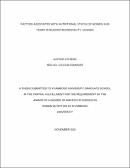| dc.description.abstract | Recent findings indicate an increase in obesity and persistent underweight among women in Uganda. Obesity, overweight and underweight have been associated with diet and physical activity. It is however not clear which socio demographic, physical activity and dietary factors are most important influencers of nutritional status among urban women in Uganda. Identifying these will go a long way in determining appropriate intervention strategies for the control of obesity and the associated complications in Uganda.
The aim of the study was to assess the prevalence of underweight, overweight and obesity and how they are associated with socio demographic, dietary and physical activity factors among women 18-59 years in Mukono Municipality. Participants were randomly selected. A semi structured socio demographic questionnaire, semi quantitative food frequency questionnaire and the Global Physical Activity Questionnaire were used to collect data. Data was analyzed using SPSS version 20, frequencies and percentages used to ascertain the prevalence and multinomial logistic regression models used to predict factors at 95% confidence interval.
The study revealed that prevalence of BMI-defined overweight was 29.7%, obesity 20.7% and underweight 2.9%. Older women were less likely to have healthy WHR (AOR 0.2; 95% CI: 0.04-0.90; P<0.05), those with moderate monthly expenditure were less likely to be obese (AOR 0.3; 95% CI: 0.1-0.9; P<0.05). Frequent consumption of foods from: meat and eggs group increased the likelihood of having excessive abdominal fat (AOR 1.7; 95% CI: 1.02-2.8; P<0.05), (AOR 1.2; 95% CI: 1.0-1.5; P<0.05) respectively, nuts and seeds increased the likelihood of being overweight (AOR 1.2; 95% CI: 1.0-1.5; P<0.03), plantains decreased the likelihood of healthy waist circumference (WC) (AOR 0.8; 95% CI: 0.7-0.9; P<0.01), poultry decreased the likelihood of moderately unhealthy WC (AOR 0.7; 95% CI: 95% CI:1.0-1.4; P<0.05). There was low (31%) attainment of minimum dietary diversity for women. Non-participation in active transport related physical activity (PA) increased the likelihood of being over fat (AOR=1.8 95% CI: 1.5–3.0; P<0.05) while more time spent in work related PA decreased the likelihood of having severely unhealthy WHR (AOR=0.9 95% CI: 0.9–2.0; P=0.01). Attainment of WHO standard of PA was at 47.1%.
In conclusion, obesity and abdominal obesity were prevalent among the respondents. They are associated with age, high parity, expenditure per month, time spent in work activity and reliance on walking for transport. They are also associated with a high frequency of consumption of meat, eggs, nuts and seeds and with a low consumption of poultry and vegetables.
Key words: Socio demographic, diet, physical activity, nutritional status and women. | en_US |

